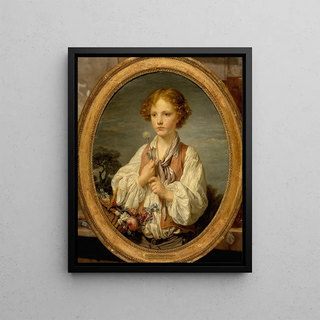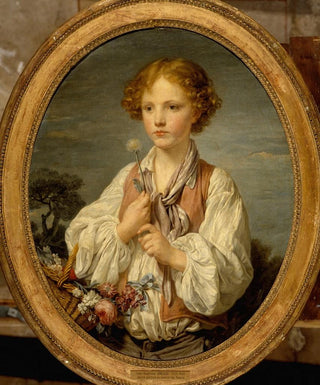Art print | Young shepherd trying his luck to find out if he is loved by his shepherdess - Jean-Baptiste Greuze


View from behind

Frame (optional)
In the universe of 18th-century painting, Jean-Baptiste Greuze stands out for his ability to capture human emotions with rare intensity. The art print "Young shepherd who tries his luck to find out if he is loved by his shepherdess" perfectly embodies this sensitivity. Through this piece, the artist immerses us in a suspended moment, where youthful innocence blends with the uncertainties of love. The young shepherd, with a gaze that is both dreamy and anxious, seems to question destiny with touching fervor. This scene, both intimate and universal, evokes the aspirations and fears of every loving heart, resonating within us echoes of our own quest for affection.
Style and uniqueness of the work
Greuze's style is characterized by fine execution and particular attention to detail. In "Young shepherd who tries his luck to find out if he is loved by his shepherdess," the delicate features of the protagonist's face reveal a rich emotional palette. The light, skillfully orchestrated, highlights the nuances of his expression while creating a striking contrast with the background. The artist uses soft, warm colors, evoking an atmosphere of tenderness and melancholy. The composition, centered on the shepherd, allows the viewer to feel the intensity of his romantic dilemma. Greuze, master of portrait and visual storytelling, manages to transcend the simple art print to offer a true story, where each look and gesture is loaded with meaning.
The artist and his influence
Jean-Baptiste Greuze, born in 1725, established himself as one of the most influential painters of his time. His innovative approach to portraiture and genre scenes marked a break from the academic conventions of his era. Greuze focuses on everyday life and human emotions, moving away from historical or mythological subjects often favored by his contemporaries. His style not only influenced his peers but also left a lasting imprint on future generations of artists. Through his works, he managed to establish a

Matte finish

View from behind

Frame (optional)
In the universe of 18th-century painting, Jean-Baptiste Greuze stands out for his ability to capture human emotions with rare intensity. The art print "Young shepherd who tries his luck to find out if he is loved by his shepherdess" perfectly embodies this sensitivity. Through this piece, the artist immerses us in a suspended moment, where youthful innocence blends with the uncertainties of love. The young shepherd, with a gaze that is both dreamy and anxious, seems to question destiny with touching fervor. This scene, both intimate and universal, evokes the aspirations and fears of every loving heart, resonating within us echoes of our own quest for affection.
Style and uniqueness of the work
Greuze's style is characterized by fine execution and particular attention to detail. In "Young shepherd who tries his luck to find out if he is loved by his shepherdess," the delicate features of the protagonist's face reveal a rich emotional palette. The light, skillfully orchestrated, highlights the nuances of his expression while creating a striking contrast with the background. The artist uses soft, warm colors, evoking an atmosphere of tenderness and melancholy. The composition, centered on the shepherd, allows the viewer to feel the intensity of his romantic dilemma. Greuze, master of portrait and visual storytelling, manages to transcend the simple art print to offer a true story, where each look and gesture is loaded with meaning.
The artist and his influence
Jean-Baptiste Greuze, born in 1725, established himself as one of the most influential painters of his time. His innovative approach to portraiture and genre scenes marked a break from the academic conventions of his era. Greuze focuses on everyday life and human emotions, moving away from historical or mythological subjects often favored by his contemporaries. His style not only influenced his peers but also left a lasting imprint on future generations of artists. Through his works, he managed to establish a






